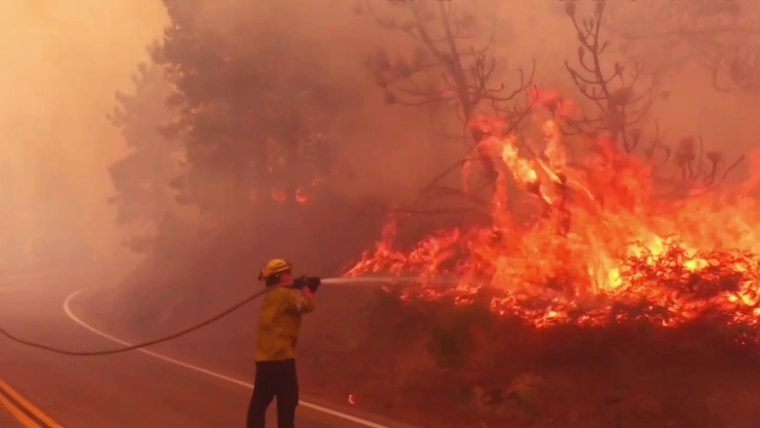One of America’s most popular national parks, Yosemite, was closed Thursday as wildfires continued to scorch the West Coast, filling the air with toxic smoke and prompting evacuations in Southern California, officials said.
The federal government-run air quality monitor, Airnow.gov, showed that pollutant levels in the park were so high they exceeded the site’s index.
Dangerous air quality is expected in the park, which is spread across nearly 1,200 square miles in the Sierra Nevada Mountains, for the next several days, the park service said. It isn’t clear when Yosemite will reopen.
Two wildfires were burning in or near the park, including the massive Creek Fire to the south. The 244,756-acre blaze ignited earlier this month, trapping dozens of people at a campground in the Sierra National Forest and destroying hundreds of homes and other buildings.
The fire was 18 percent contained Thursday.
To the south, the Bobcat Fire continued to burn across thousands of acres of national forest land in the San Gabriel Mountains, just north of Los Angeles.
While firefighters have so far kept it from damaging a historic observatory in the Angeles National Forest, the fire roared overnight toward Juniper Hills, an unincorporated community of roughly 400 houses in the San Gabriel foothills.
The Los Angeles County Sheriff’s Department issued evacuation orders for Juniper Hills and other nearby communities Thursday afternoon.
David Borden, an aeronautical engineer and president of the Juniper Hills Community Association, said he saw flames from the fire a couple of miles from his home early Thursday morning while preparing to go to work in the nearby city of Palmdale.
So Borden, 62, loaded his birth certificate, musical instruments, family pictures and other personal items into his car before leaving. While speaking to a reporter Thursday afternoon, he was returning to Juniper Hills to see if his home was still there.
He said he wasn’t sure how far he’d get or where he’d stay if he couldn’t get home.
“After a certain point, what can you do?” he said. “It’s like complaining that it’s raining outside. You might as well deal with it.”
A record 3.4 million acres have burned in California this year, a staggering number that officials and experts have attributed to climate change and a buildup of dried vegetation. Twenty-five people have died in the state, and 5,400 structures have burned in the fires.
In Oregon, where fast-moving wildfires have scorched more than 1 million acres, destroyed more than 1,000 homes and killed eight people, Travis Cook told NBC affiliate KGW that his mother and brother died while waiting to evacuate from her home in the Elkhorn Valley, east of Salem.
When Travis Cook spoke to his mother, Cathy Cook, 71, last week, she said she and Travis’ brother, Justin Cook, 41, had packed their bags and were awaiting the order to leave, KGW reported. But Travis Cook said the order appears to have come too late — a search-and-rescue team found their bodies near her home in a neighborhood decimated by the Beachie Creek Fire.
“It feels like a nightmare,” Travis Cook told the station. “I still cannot believe — I wake up in the mornings and it’s just, like, is this really happening?”
Speaking to reporters Thursday, Gov. Kate Brown called the devastation from the blaze, which was 191, 238 acres and 20 percent contained, “all-encompassing and shocking.”
Still, she said the forecast had good news: Rain is expected on the coast, as well as both slopes of the Cascade Mountains, which span the length of the state, beginning Thursday night. Another official, Andrew Phelps, director of the Oregon Office of Emergency Management, said that rain could cause flooding the areas that have burned, however.
The National Weather Service had issued flash-flood watches across the state, he said, “so please be cognizant of that.”












